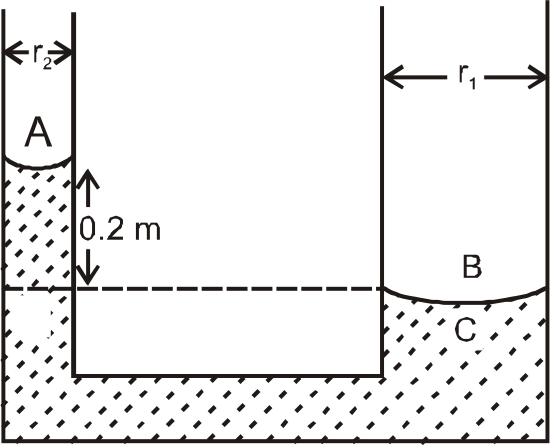A barometer contains two uniform capillaries of radii 1.4×10−3m and 7.2×10−4m. If the height of liquid in narrow tube is 0.2m more than that in wide tube, calculate the true pressure difference. Density of liqid =103kg/m3, surface tension =72×10−3N/m and g=9.8ms−12.
Let the presures in wide and narrow limbs of P1 and P2, respectively. If R1 and R2 be the radii of meniscus in wide and narrow limb pressure just below hhe meniscus of wide tube =P1−2TR1 and pressure just below the meniscus of narrow limb =P2=2TR2.
Therefore, difference of these pressures
(P1−2TR1)−(P2−2TR2)=hρg
Therefore, true pressure difference,
P1−P2=hρg−2T(1R2−1R1)
For the water and glass surface, takingg in the angle of contact θ to be zero, we have R1=r1cosθ≈r1 and R2=r2cosθ≈r2 where r1 and r2 are radii of wide and narrow limbs, respectively.
∴P1−P2=hρg−2T(1r2−1r1)=0.2×103×9.8−2×72
×10−3×(17.2×10−4−11.44×10−3)
=1.96×103−0.10×103=1.86×103N/m2=1860N/m2
Topper's Solved these Questions
- BOOK - CENGAGE PHYSICSCHAPTER - PROPERTIES OF SOLIDS AND FLUIDSEXERCISE - Exercise 5.112videos
PROPERTIES OF SOLIDS AND FLUIDS
- BOOK - CENGAGE PHYSICSCHAPTER - PROPERTIES OF SOLIDS AND FLUIDSEXERCISE - Exercise 5.26videos
PROPERTIES OF SOLIDS AND FLUIDS
- BOOK - CENGAGE PHYSICSCHAPTER - PROPERTIES OF SOLIDS AND FLUIDSEXERCISE - INTEGER_TYPE2videos
PROPERTIES OF SOLIDS AND FLUIDS
- BOOK - CENGAGE PHYSICSCHAPTER - NEWTON'S LAWS OF MOTION 2EXERCISE - Integer type1videos
NEWTON'S LAWS OF MOTION 2
- BOOK - CENGAGE PHYSICSCHAPTER - RIGID BODY DYNAMICS 1EXERCISE - Integer11videos
RIGID BODY DYNAMICS 1
Similar Questions
A barometer contains two uniform capillries of radii 1.44×10−3m and 7.2×10−4m. If the height of the liquid in the narrow tube is 0.2m more than that in the wide tube, calculate the true pressure difference. Density of liquid =103kg/m3, surface tension =72×10−3N/m and g=m/s2.
View SolutionThe limbs of a manometer consist of uniform capillary tubes of radii are 10−3&7.2×10−4m find out the correct pressure difference if the level of the liquid in narrower tube stands 0.2 m above that in the broader tube. (density of liquid =103kg/m3, surface tension =72×10−3N/m)
View Solution
Knowledge Check
- Question 1 - Select One
Two seperate soap bubbles of radii 3×10−3 m and 2×10−3 m respectively, formed of same liquid (surface tension 6.5×10−2 N/m) come together to form a double bubble. The radius of interface of doubl bubble is
A6×10−3 mB4×10−3 mC1.5×10−3 mD0.66×10−3 m - Question 2 - Select One
The breaking force of wire is 104N and radius is 1×10−3m. If the radius is 2×10−3m, then the breaking force will be
A4×104NB40×104NC0.04×104ND0.4×104N - Question 3 - Select One
If water rises in a capillary tube upto 3 cm . What is the diameter of capillary tube (Surface tension of water =7.2×10−2N/m)
A9.6×10−4mB9.6×10−3mC9.6×10−2mD9.6×10−1m
The limbs of a manometer consists of uniform capillary tubes of radii 1.44×10−3m and 7.2×104m. If the level of the liquid in the narrower tube stands 0.2 m above that in the broader tube, pressure difference between A and B is found to be 310λN/m2. Here λ is an integer. Find λ (density = 103kg/m3, surface tension = 72×10−3N/m). (take g=9.8m/s2)
 View Solution
View SolutionCalculate the speed of longitudinal wave in steel. Young's modulus for steel is 3×1010N/m2 and its density 1.2×103kg/m3
View SolutionTo what height does the liquid rise in a capillary tube of radus 0.25 mm, when dipped in a liquid of density 0.8×103kgm−3 and surface tension 0.05 N m−1? Given (cosθ=0.4)
View SolutionCalculate the speed of longitudinal wave in steel. Young's modulus for steel is 3×1010N/m2 and its density 1.2×103kg/m3
View SolutionWater rises in a capillary tube of diameter 0.2×102m upto a height of 1.5 cm. The surface tension of water is-
View Solution

